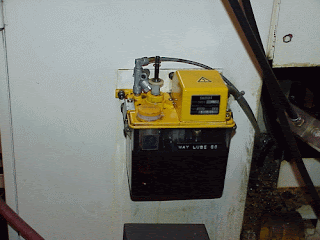Your CNC machine is equipped with an automatic oiler system. Great ! You won’t have to think about oiling the machine and an alarm will tell you when the tank is dry. What a great device ? Right ?
Well, that is the design. Unfortunately, along with the “automatic” description of the system comes the “out of sight, out of mind” aspect of the system. Because many people know it is an automatic system, many people put it out of their minds and simply wait for the alarm to come up showing that the tank is empty and needs to be filled. But what if that alarm never comes on because the tank isn’t empty ? Why wouldn’t the tank be empty ?
As your machine gets older, the way lube system will require service just like any other mechanism. The main problem, which often gets overlooked, is that the “tank empty” alarm never comes on because the tank never drains and nobody ever notices it. Now your machine runs for months on end with no lubrication on the ways and when you finally notice a problem, it’s too late. Here is the “Rest of the Story …”
PROBLEM : The machine’s ways are not receiving any way lube oil.
SYMPTOMS – IN ORDER OF SEVERITY :
- Positioning / Repeatability Problems
- Axis makes noise when moving
- Axis Drive motor overload alarm coming when the axis is moving
POSSIBLE CAUSES :
- Way Lube Pump burned out.
- Way Lube Pump distribution flow set too low.
- Way Lube Pump filter CLOGGED
- Way Lube line BROKEN
- Metering Units are CLOGGED
POSSIBLE CAUSES EXPLAINED :
(1) Way Lube Pump Burned Out : If the way lube pump is burned out, obviously there will not be any lube getting into the system. These pumps are usually set using a timer system. There is basically two types of timer systems used :
- The pump is on a cam and the way it works is that the pump is always running. One gear turns another which acts like a step-down system and the second gear raises a “primer” lever. When the lever reaches the top of the stroke, the “primer” lever is released and the oil is pushed into the lines. This whole cycle can take 5-20 minutes meaning that even though the pump is always running, the lines get lube only every 5-20 minutes.
- How to Check It : Take a flashlight and look in the tank or remove the oil tank. Once looking inside, you can see the main gear that should be constantly moving. It may be at a very slow pace, but you will see it moving.
- The pump is set to an electrical timer set in the controls PC (programmable controller) or an actual physical electrical timer in the cabinet. This type of timer only supplies power to start the pump for every cycle.
- How to Check It : On some pumps there is no primer lever but a light comes on on the tank when the pump is activated. Make sure this light comes on every 5-20 minutes or some other sign comes on to show the pump is activated every 5-20 minutes.
(2) Way Lube Pump distribution flow set too low : As stated above, the way lube pump usually is set using a timer system. The flow amount that gets distributed into the lines during every cycle is usually set and adjusted at the pump with a manual setting mechanism. This type of adjusting mechanism is usually a knob that can be turned higher or lower to set more or less flow. Also, just look at the primer lever. During the mentioned 5-20 minute cycle, you should see the primer lever raise slowly and then start to drop after reaching the top of the cycle. Check the stroke of the lever – short stroke, less flow.
- How to Check It : The normal pump usage is in an 8 hour shift, you should fill the tank every 2-3 days. Also, you should see way lube flowing onto the ways. Always remember, the more flow the better. Yes, it may contaminate the coolant but that is better than ruining the ways and thus the machine just to save a couple of bucks.
(3) Way Lube Pump filter CLOGGED : The way lube tank usually has a filter between the tank itself and the oil line that starts the distribution. This filter is usually in the tank itself at the bottom of the primer lever or in-line right after the main distribution line leaves the tank. It will get clogged over time, especially if there is no filter at the oil fill hole or if someone takes off the filter when filling the tank.
- How to Check It : Disconnect the main lube line where it exits the tank to feed the system or after the in-line filter if so equipped. When the cycle reaches the pump stage as outlined above, oil should flow through this connection. The flow should be strong at this point. If not, remove the oil tank and search out the filter or remove the in-line filter. They can often be cleaned with a cleaner but the best remedy is to replace it.
(4) Way Lube line BROKEN : Oftentimes a lube line in the system gets crimped or broken during machining or during service. These way lube systems are usually “pressurized” so to speak and if the pressure is released at one point, say at the broken line, the oil will flow all to that point, depriving all the other lines of fluid.
- How to Check It : When the pump is in the pumping stage, the primer lever should fall slowly. This is due to the fact that it is pushing the oil into the system. If a line is broken, the primer lever will fall quickly as all oil is funneled to the broken line area only. On systems without a primer lever, the pump may have a pressure gauge on the pump. During the pumping cycle, the pressure should register for a couple of seconds as the oil is pumped into the lines. If the pressure is low or does not come up at all during the pumping cycle, a line in the system may be broken.
(5) Metering Units are CLOGGED : In order to create the “pressure” of the system needed for even distribution, each oil line leads to a “metering unit” where the flow is lowered and the oil is discharged. When the pump forces oil into the lines, they all fill and flow to the metering units where the flow is stopped. Each metering unit is set to discharge the desired amount or “drops” of oil and perform their individual duties. Since some areas require more lube, the metering units can be different for each line or area. Since these metering units have actual valve type components in their very small bodies, over time these units can be become clogged or the inner workings can become stuck.
- How to Check It : This is a much harder area to check. The best remedy and prevention is to change these units every year as part of a yearly maintenance program. Because these units allow only drops to flow through, they are harder to see when troubleshooting. These metering units are usually located in “clumps” around the machine. Several lines lead to these central areas and lube lines are branched out from here to the various areas of the machine. Replacement metering valves should be obtained from the machine tool builder or dealer to insure that you are getting the correct replacement part. When changing these units, pay close attention to the flow arrow that is commonly marked on the units themselves. This arrow shows the direction of installation and flow. Check the original unit before removal and replace accordingly.
Due diligence and a little tracking will insure your Happy ( and ACCURATE ) Chip Making for years to come !!
Conversational CAD/CAM
Quoting & Estimating
G Code Conversion
CNC Training
…. and MORE !!!



